

Panorama Red
Item no.: MD0101R- Special mixture inlcuding red and scarlet shades
- Crop Time
- Spring: 19 - 23 weeks
- Height ∅
- 35 ″ / 90 cm
- Exposure
- Sun - Partial shade
- Seed Form
- Raw Seed
- Heat Zone
- 9-2
- Hardiness Zone
- 4b-9b
- Best Uses
- Bedding, Cutflower
Culture guide
Usage
Perennial for border and bedding, medicinal plant, attractive for bees, cut flower production
Sow time
March-May for green pots and cut flower production June-August for flowering in pots the following year
Sowing method
1-3 seeds per plug, can be sown directly into final pots
Germination
Germinates in 14-20 days at 68-72 °F (20-22 °C). Cover seed lightly with vermiculite after sowing.
Growing on
Transplant plugs after 5 weeks. Grow on at 55-65 °F (13-18 °C) in a well-drained, humus medium. Vernalization is required for flower initiation. After vernalization, begin forcing plants at 60-65 °F (15-18 °C) for 12 weeks under long days.
Media
Use a well-drained, growing substrate with 15-30 % clay, 0-20 % parts (e.g. bark, perlite, sand), 1,5-3 kg/m³ complete balanced fertilizer, 0-3 kg/m³ slow release fertilizer (3-9 months), iron-chelate, micronutrients, pH: 5.5-7.0. Field: loamy sandy to sandy loamy soils, with a good drainage. Standard fertilization: 80-100 g/m² of a slow release fertilizer.
Temperature
Grow at 12-18 °C during day time and at 10-13 °C during night or outdoors. In winter indoors frost free at 3-5 °C or outdoors. In spring the plants start to grow for 10 weeks at 15-18 °C and long day. Cold temperatures at 8-13 °C will increase the cultivation time. A chilling period for flower initiation is required. Cultivation at warm temperatures will require high light levels. At low light levels cold temperatures are required for a good plant and stem quality.
Fertilization
High fertilization levels are required. Fertilize the crop weekly with 150-200 ppm nitrogen (at 3 kg/m³ slow release fertilizer in substrate), using a complete balanced fertilizer. Avoid high ammonium levels. Don’t fertilize after mid September. In spring fertilize with 100-150 ppm nitrogen of a potassium balanced fertilizer (N: K2O-ratio: 1:1,5). Prevent magnesium deficiency by applying magnesium sulphate (0,05 %) 1-2 times and in case of iron deficiency apply iron-chelate for 1-2 times. Field: If necessary according to analysis, improve the soil with 80-100 g/m² of a slow release fertilizer per year, applied in several portions.
Stage I Starts with the radicle breaking through the testa. The roots are touching the medium. Ends with fully developed cotyledons.
Stage II Starts from fully developed cotyledons. Ends with the fully developed true leaf or true leaf pair.
Stage III Starts from the fully developed true leaf or true leaf pair and ends with 80% of the young plants being marketable.
Stage IV All young plants are ready for sale and in the process of being hardened off. This stage lasts about 7 days.
The cultural recommendations are based on results from trials conducted under Central European conditions. Different conditions in other parts of the world may lead to deviations in results achieved.
